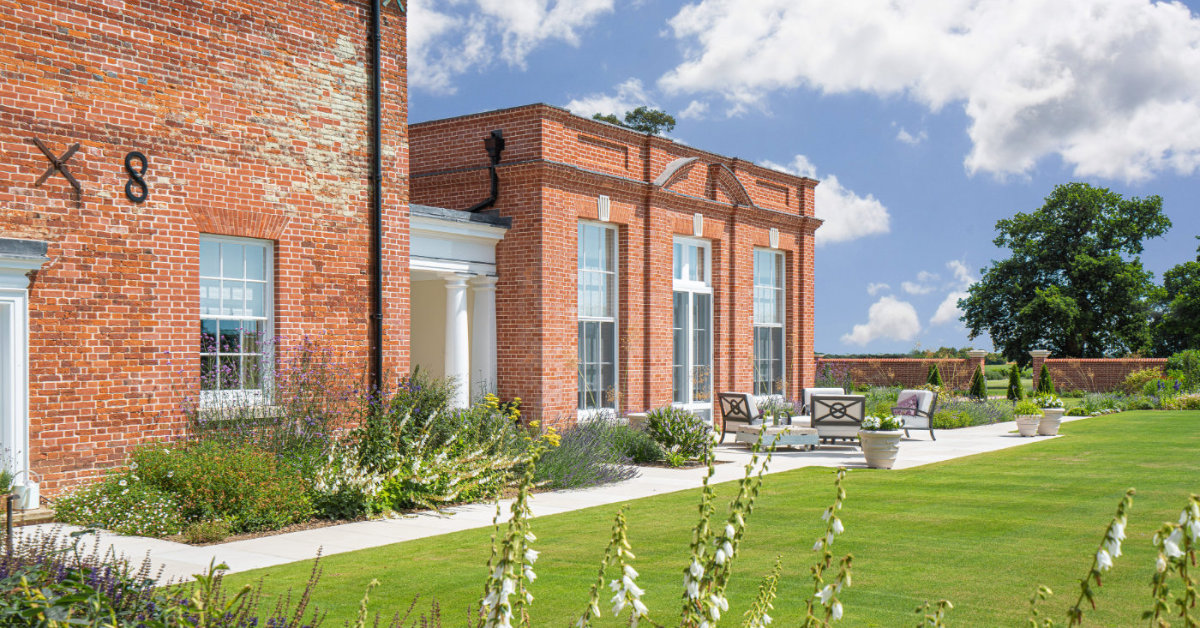House in Wiltshire
Part of the joy of so many English country houses is the layered stories in which they are steeped: the distinctive and attractive form that comes from additions and contractions across centuries, and the underlying sense of how they are shaped by the lives led within them. Since the Regency, architects have designed houses that echo this narrative form, which imply history and reflect the aesthetic of these older houses. Edwin Lutyens was a master of such compositions, designing new houses that on one level feel like sketches of old organic houses, but with all the advantages of better building systems. This new house in Wiltshire, completed in 2018, is a contemporary demonstration of this same theme, resulting in a finely modelled house, a two-story, five-bay classical block with low two-storey wings, mansard roofs and an additional eastern range that faces a walled garden.
The house was designed by Francis Terry, one of the leading younger classical architects in practice today.
According to Terry, “the truth is we designed this house from the inside out: thinking about how life would be lived and the rooms that were needed, and then developed the best classical form for the exterior: life came first.”
Terry is well known for his draughtsmanship and for his skill in drawing out sketch elevations and plans by hand as they are discussed with clients.
In fact, the first part of the project to be realised was the summer house – part pool house, part retreat from the main house – which provided the arena for family recreation. It is a simple classical pavilion, with a portico with a shaped gable as a pediment – with reference to the work of Oliver Messel, the gifted theatre designer who turned to architectural projects in the 1960s and ‘70s, especially in Barbados and Mustique.
Within the summer house there is a generously scaled large family living room, with changing rooms and a place for al fresco meals in front. It is set in a new walled garden, of traditional vernacular built in brick and flint, and planted with borders on which the garden designer Rupert Golby advised. Golby is skilled in the subtle reinterpretation of the romantic classic English garden tradition with simpler planting and a sense of connection with the wider setting. The summer house project provided something of a trial run for the main house, and much pleasure was achieved in the realisation of the union of architecture, garden and landscape.
The main house is also satisfyingly simple, and despite its plain, crisp ashlar walls, and the formal rhythm of its sash windows and pedimented dormers, it has a sculpted, slightly baroque feel in the way the shadow is cast between the connected blocks of the composition. There is a dignified, alert quality to the property, which owes much to the rigorous proportions of the house, windows and wings.
The house is faced in a light, creamy Bath stone ashlar, under a slate roof, and set against a wooded backdrop: the south front looks out over a lake. It is the result of years of planning and careful design and artisanship (Ketton Stone for the facing ashlar, R.W. Armstrong builders, joinery by S.B. Joinery and plasterwork by Stevensons of Norwich).
The contained quality of the exterior leads to a genuine sense of surprise inside: the house has generously scaled interiors, and tall sash windows flood the rooms with light. The main entrance hall is designed to link with a cross-axial corridor, the passage being indicated by a screen of columns, echoing the arrangements in eighteenth-century houses such as Dumfries House in Ayrshire, Scotland, behind which is an apsidal staircase compartment with a finely detailed oak staircase.
The well-proportioned drawing room and billiard room, separated by double doors, fill the south front, and have fine views across the wider landscape. The long dining room, kitchen and breakfast room are situated at the east end, with other supporting spaces, including a generous inner hall and boot room, that essential space of country-house life. The breakfast room is especially attractive, with a Venetian window facing east, to enjoy the morning sun. On the first floor a long, broad axial corridor links the bedrooms, and those in the wings are also more low ceilinged, which gives them a homely feel.
The interiors are mellow and bright, with inherited furniture from other family homes, comfortable upholstered chairs and sofas. Interior design advice was also provided by Jane Ormsby Gore, who grew up on the Welsh borders. Her father, Lord Harlech, was ambassador to the US, so she lived for a while in the famous Lutyens-designed embassy there, and has a good understanding of classical interiors; she has worked on numerous country-house interiors, from Ashdown House in Berkshire to Chilham Castle in Kent.
Throughout the rooms there is an emphasis on comfort, ease of circulation and appropriateness. Colours are in an earthy natural range and pleasantly recessive, such as Naples Yellow, a primrose yellow and a soft moss green in principal rooms, where there are full curtains at the windows and good quality upholstered furniture with touches of Indian and Middle Eastern fabrics in the cushions.
Building a new house in the country is a particular challenge, but here it was met with considerable thought, research and design imagination. The house forms a new chapter in the continuing history of English classical country-house design in the twenty-first century.
This was one of Francis Terry’s first independent projects, and combines imaginatively so many strands of the English country-house tradition with modern taste and technology. It has proved to be a happy home for his clients and their family.
Text adapted from Romantics & Classics: Style in the English Country House by Jeremy Musson, published by Rizzoli in 2021

















